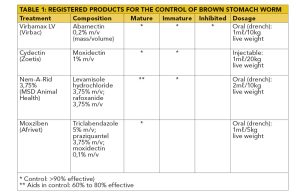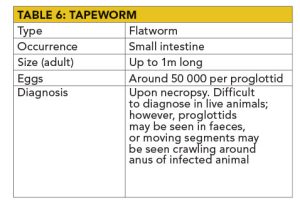
Photo: FW Archive
Internal parasites can cause severe economic losses for sheep farmers in South Africa. In the country’s winter rainfall region, the most important of these parasites, according to Drs Gareth Bath and Jan de Wet, are the brown stomach worm (Teladorsagia circumcincta), tapeworm (Moniezia spp.), liver fluke (Fasciola hepatica), and the long-necked bankrupt worm (Nematodirus spathiger and N. filicollis).
In the summer rainfall region, the most important internal parasites are wireworm (Haemonchus contortus), tapeworm, bankrupt worm, and liver fluke.
It’s essential for farmers to treat these parasites with effective registered medicines, but the parasites’ resistance to available treatments is a growing concern around the world. Thus, farmers are advised to implement prevention methods to lower parasite loads on their farms, such as the effective quarantining of infected animals.
Brown stomach worm
The brown stomach worm (see Table 2) is a roundworm found in the abomasum (fourth/true stomach) of the sheep. It is a small, red-brown worm that’s about 10mm long, and is visible on the lining of the abomasum.

Adult worms lay 50 to 100 eggs per day. If their environment isn’t conducive to reproduction, they may become inactive; however, they will resume activity once conditions have improved.
According to animal health company Virbac, the worm causes damage to the lining of the abomasum as it matures from larva to adult.
Some signs and symptoms of infestation are lethargy, weight loss, weakness and diarrhoea. With serious infestation, the animal’s condition may decline rapidly, and death may follow.
Virbac states that sheep may lose up to 35% of their weight due to a lack of appetite and a loss of protein. Wool growth and milk production may also fall by 20% before symptoms become apparent. Timely treatment is required to reduce the risk of death.
Upon necropsy, the lining of the abomasum will show damage, and may be thickened and inflamed. White nodules of 1mm to 2mm in diameter may also be evident. The carcass will have little to no fat, and may appear emaciated. Animals should be treated with the relevant registered products (see Table 1).

Liver fluke
As the name implies, liver fluke (see Table 3) is a flatworm that infects the liver of sheep. Adult fluke are between 2cm and 3cm long, and live in the bile ducts of the infected animal. Eggs are excreted via the animal’s faeces.

The intermediate host of liver fluke is Galba truncatula, a species of snail. The fluke develops in the snail, hatches out onto the pasture, and forms a cyst on the grass that is then ingested by the sheep.
It is the immature fluke that causes damage to the liver, since it migrates through the organ during its development into an adult. Acute, subacute and chronic fasciolosis can occur, depending on the degree of infestation and the animal’s resilience.
Acute cases occur around three weeks after high numbers of immature flukes are ingested. Blood loss and secondary infections can transpire. Animals may suddenly die, while others may be lethargic and experience loss of appetite. They may also be reluctant to run due to abdominal pain. Sudden death occurs in around 10% of cases.
Subacute cases present with a rapid loss of body condition and poor fleece quality. Some sheep may demonstrate severe depression, lack of appetite and weakness, and may be unable to stand. Subacute fluke can have a major impact on growth rate, milk yield, finishing weight, and body condition. Mortality rates can be high, but deaths are usually only seen after a period of clinical signs.
Chronic cases present with very poor body condition and fleece quality, and bottle jaw (swelling of the jaw caused by accumulation of fluid in the submandibular tissue). Affected sheep may die in an emaciated state, especially during the high metabolic demands of advanced pregnancy or early lactation.
Upon necropsy, severe liver damage may be evident. Mature flukes may be found in the bile ducts of the liver and gallbladder. Treatment requires the administering of the applicable registered products (see Table 4).

Tapeworm
The tapeworm (see Table 6) is a type of flatworm found in the small intestines of sheep and other mammals. In sheep, adult tapeworms can reach lengths of up to 1m. The ribbon-shaped worm attaches to the inner surface of the small intestine with its suckers, which are located on the scolex (head) of the parasite.

The tapeworm is made up of segments, known as proglottids, each of which includes a set of both male and female gonads, which means each segment can fertilise itself or those nearby as needed. Moniezia, the species that affects sheep, is the most important species in South Africa’s winter rainfall area.
Tapeworms need intermediate hosts, and in the case of Moniezia, the intermediate hosts are oribatid mites. These mites ingest the eggs that have been expelled through an infected animal’s faeces, and the larval stages of the worm develop inside the mites. Sheep become infected when ingesting the microscopic pasture mites while feeding.
Signs and symptoms of tapeworm infection include scours, emaciation, pot belly, and weight loss. If infestation is severe enough, the parasites can cause bowel obstruction, which may lead to death. Sheep may also be the intermediate hosts for other mammals, such as dogs, according to Bath and De Wet. Only registered products (see Table 5) should be used for the treatment of tapeworm.

Long-necked bankrupt worm
Long-necked bankrupt worms are thin-necked roundworms that occur in the small intestine of an infected animal (see Table 7). They show great resilience and can survive in very cold and dry conditions.

Signs and symptoms of infestation include lethargy, collapse, weight loss and scours. Death may also occur. Most damage is caused by the immature worms.
As with the treatment of other parasites, only registered products should be used (see Table 8).

Wireworm
Wireworm (see Table 9), also known as barber’s pole worm, is a roundworm found throughout the world. The parasites attach to the lining of the sheep’s abomasum and feed on blood.

They produce the highest number of eggs out of all the types of worms found in sheep. Eggs are excreted via the faeces of infected animals. The eggs are then ingested by other animals while grazing. Haemonchosis, the condition that results from infestation with wireworm, causes large economic losses for farmers around the world.
Signs and symptoms of infection include anaemia, bottle jaw, weight loss, and reduced wool growth and tensile strength, as well as lethargy, depression and pallor. In lactating ewes, milk production may decline. Severe infestation may lead to death. Once again, farmers must treat their animals with the appropriate medicines (see Table 10).

In conclusion, the treatments listed here are but a few of many, and farmers are encouraged to consult their animal health technicians or veterinarians regarding the most effective options for their animals. They must also adhere strictly to the dosage and directions of use on the label of any product they use.
For more information, visit msd-animal-health.co.za, za.virbac.com, or afrivet.co.za. FW











